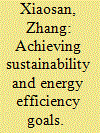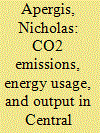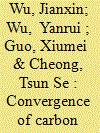|
|
|
Sort Order |
|
|
|
Items / Page
|
|
|
|
|
|
|
| Srl | Item |
| 1 |
ID:
180143


|
|
|
|
|
| Summary/Abstract |
This study examines the relationship between total renewable electricity generation, total hydroelectric generation, and carbon dioxide emissions (CO2e) for China. The autoregressive distributed lag (ARDL) model showed that renewable electricity generation, hydroelectric generation, and green innovation decreased CO2e in China from 1990 to 2018, whereas gross domestic product per capita and foreign direct investment increased CO2e. Moreover, the Granger-causality test results are as follows. First, a two-way causal flow from CO2e to foreign direct investment and CO2e to gross domestic product per capita confirmed the feedback hypothesis. Second, a one-way causal flow from hydroelectric and renewable electricity generation to gross domestic product per capita supported the energy-led growth hypothesis. Third, the causality test reflected a one-way causal flow from renewable electricity generation to foreign direct investment and hydroelectric generation to foreign direct investment and renewable electricity generation. This study asserts the need for government to introduce taxes and other incentives for solar, wind, and hydropower-related projects. The paper also calls for designing policies to improve the market attractiveness of hydroelectric generation projects through special investment programs.
|
|
|
|
|
|
|
|
|
|
|
|
|
|
|
|
| 2 |
ID:
109393


|
|
|
|
|
| Publication |
2011.
|
| Summary/Abstract |
This paper investigates methodologies to quantify CO2 emissions from cars and light trucks in Florida. The most widely used methodology to calculate greenhouse gas emissions in the transportation sector at the local level uses a harmonic average (HA) methodology based on nationally averaged fuel economies that assume 55% city and 45% highway VMTs. This paper presents a local condition (LC) methodology that accounts for county-level variations in city and highway VMTs, as opposed to assumed uniform driving conditions. Both HA and LC methodologies were used to estimate and compare absolute and per capita CO2 emissions both statewide and counties for 2000 and 2008. From 2000 to 2008, statewide absolute and per capita CO2 emissions increased similarly using HA and LC methodologies; however, the percent change varied considerably among counties. Statewide CO2 emissions calculated from HA and LC methodologies differed by only -0.2% (2000) and 1.7% (2008); however, the differences in the county-level emissions ranged from -8.0% to 14.9% (2000) and from -5.6% to 17.0% (2008). While either the HA or the LC methodology yields a similar result statewide, significant variation exists at the county level, warranting the need to consider local driving conditions when estimating county-level emissions.
|
|
|
|
|
|
|
|
|
|
|
|
|
|
|
|
| 3 |
ID:
112917


|
|
|
|
|
| Publication |
2012.
|
| Summary/Abstract |
This paper explores the relationship between CO2 emissions and economic activity for 31 countries (28 OECD, Brazil, China, and India) during the period 1950 to 2006 using cointegration analysis. Single country long run relationships are estimated, and equality in the functional form, the parameters, and the turning point, when appropriate, are rejected. This confirms the relevance of considering the differences among countries in the relationship between air pollution and economic activity to avoid wrong estimations and conclusions.
|
|
|
|
|
|
|
|
|
|
|
|
|
|
|
|
| 4 |
ID:
109334


|
|
|
|
|
| Publication |
2011.
|
| Summary/Abstract |
This paper examines the causal relationships between carbon dioxide emissions, energy consumption and real economic output using panel cointegration and panel vector error correction modeling techniques based on the panel data for 28 provinces in China over the period 1995-2007. Our empirical results show that CO2 emissions, energy consumption and economic growth have appeared to be cointegrated. Moreover, there exists bidirectional causality between CO2 emissions and energy consumption, and also between energy consumption and economic growth. It has also been found that energy consumption and economic growth are the long-run causes for CO2 emissions and CO2 emissions and economic growth are the long-run causes for energy consumption. The results indicate that China's CO2 emissions will not decrease in a long period of time and reducing CO2 emissions may handicap China's economic growth to some degree. Some policy implications of the empirical results have finally been proposed.
|
|
|
|
|
|
|
|
|
|
|
|
|
|
|
|
| 5 |
ID:
089005


|
|
|
|
|
| Publication |
2009.
|
| Summary/Abstract |
This study extends the recent work of Ang (2007) [Ang, J.B., 2007. CO2 emissions, energy consumption, and output in France. Energy Policy 35, 4772-4778] in examining the causal relationship between carbon dioxide emissions, energy consumption, and output within a panel vector error correction model for six Central American countries over the period 1971-2004. In long-run equilibrium energy consumption has a positive and statistically significant impact on emissions while real output exhibits the inverted U-shape pattern associated with the Environmental Kuznets Curve (EKC) hypothesis. The short-run dynamics indicate unidirectional causality from energy consumption and real output, respectively, to emissions along with bidirectional causality between energy consumption and real output. In the long-run there appears to be bidirectional causality between energy consumption and emissions.
|
|
|
|
|
|
|
|
|
|
|
|
|
|
|
|
| 6 |
ID:
169743


|
|
|
|
|
| Summary/Abstract |
This paper estimates changes in the cost of electricity, reliability, and atmospheric emissions resulting from large penetration of residential roof-top Photovoltaic (PV) and end-use energy efficiency (EE) within the service areas of Duke Energy in the Carolinas, where nuclear power plants account for almost 50% of electricity generation.
|
|
|
|
|
|
|
|
|
|
|
|
|
|
|
|
| 7 |
ID:
150890


|
|
|
|
|
| Summary/Abstract |
This paper investigates the spatial dynamics of per capita carbon dioxide (CO2) emissions in China. The analyses are conducted by employing a continuous dynamic distribution approach and panel data of 286 cities at the prefecture and above-prefecture level. The results show that per capita CO2 emissions tend to converge during the sample period of 2002–2011. However, multimodality is found in the ergodic distribution of the full sample. It is also found that there is more persistence in cities with low per capita CO2 emissions, and more mobility in cities with high per capita CO2 emissions. The analyses also show that the dynamics of per capita CO2 emissions are significantly different among various geographical, income and environmental policy groups. The conditional distribution analyses indicate that multimodality cannot be explained independently by any one of the two factors, namely geographical location or income level. The findings in this study may have important policy implications for CO2 abatement in China.
|
|
|
|
|
|
|
|
|
|
|
|
|
|
|
|
| 8 |
ID:
176825


|
|
|
|
|
| Summary/Abstract |
This paper introduces an innovative line of study to the current literature, by assessing the interactions, in France, between electricity sources, and periods with differing electricity consumption; namely morning off-peak, morning peak, middle off-peak, and night peak, using high-frequency data, specifically, daily data. This paper also analyses the impact of these interactions on both the diversification of the electricity mix, and on carbon dioxide emissions. Thus, this research could help identify the conditions needed, in both supply and demand, for a successful transition towards renewable energies. A Vector Autoregressive model has been employed to detect the presence of endogeneity, and to show the interactions between electricity supply and demand. Consumption in France has been problematic for the management of a portfolio containing rigid and intermittent base load sources. High peak consumption at night has increased the necessity to deploy a flexible electricity generating source, in other words, fossil fuels, and is one of the reasons for nuclear de-activation. In comparison, high morning peak consumption is rational and desirable. Indeed, morning peaks have been satisfied by a portfolio of renewable energies, decreasing the harmful impact of electricity on the environment, and keeping electricity costs low.
|
|
|
|
|
|
|
|
|
|
|
|
|
|
|
|
| 9 |
ID:
093544


|
|
|
|
|
| Publication |
2010.
|
| Summary/Abstract |
This study examines the causal relationship between carbon dioxide emissions, energy consumption, and real output within a panel vector error correction model for eleven countries of the Commonwealth of Independent States over the period 1992-2004. In the long-run, energy consumption has a positive and statistically significant impact on carbon dioxide emissions while real output follows an inverted U-shape pattern associated with the Environmental Kuznets Curve (EKC) hypothesis. The short-run dynamics indicate unidirectional causality from energy consumption and real output, respectively, to carbon dioxide emissions along with bidirectional causality between energy consumption and real output. In the long-run there appears to be bidirectional causality between energy consumption and carbon dioxide emissions.
|
|
|
|
|
|
|
|
|
|
|
|
|
|
|
|
| 10 |
ID:
107502


|
|
|
|
|
| Publication |
2011.
|
| Summary/Abstract |
This study examines the causal relationships among energy consumption, economic growth and carbon dioxide emissions in twenty countries from Latin America and the Caribbean region. The methodology includes the use of Phillips and Perron (PP) tests, a cointegration model with vector error correction modeling (VECM) and vector autoregression (VAR) with Granger causality. The study concludes that of the twenty countries analyzed, only in four of them will it be possible to implement energy conservation polices without affecting their economic growth, four others are not able to consider an energy conservation policy with economic growth, and the other twelve should focus on their economic growth before adopting any conservation policies. Energy efficiency was found in this region, especially in the countries which have both cointegration and short-term equilibrium.
|
|
|
|
|
|
|
|
|
|
|
|
|
|
|
|
| 11 |
ID:
113445


|
|
|
|
|
| Publication |
2012.
|
| Summary/Abstract |
This article extends the recent findings of Liu (2005), Ang (2007), Apergis et al. (2009) and Payne (2010) by implementing recent bootstrap panel unit root tests and cointegration techniques to investigate the relationship between carbon dioxide emissions, energy consumption, and real GDP for 12 Middle East and North African Countries (MENA) over the period 1981-2005. Our results show that in the long-run energy consumption has a positive significant impact on CO2 emissions. More interestingly, we show that real GDP exhibits a quadratic relationship with CO2 emissions for the region as a whole. However, although the estimated long-run coefficients of income and its square satisfy the EKC hypothesis in most studied countries, the turning points are very low in some cases and very high in other cases, hence providing poor evidence in support of the EKC hypothesis. CO2 emission reductions per capita have been achieved in the MENA region, even while the region exhibited economic growth over the period 1981-2005. The econometric relationships derived in this paper suggest that future reductions in CO2 emissions per capita might be achieved at the same time as GDP per capita in the MENA region continues to grow.
|
|
|
|
|
|
|
|
|
|
|
|
|
|
|
|
| 12 |
ID:
103600


|
|
|
|
|
| Publication |
2011.
|
| Summary/Abstract |
This paper applies the panel unit root, heterogeneous panel cointegration and panel-based dynamic OLS to re-investigate the co-movement and relationship between energy consumption and economic growth for 30 provinces in mainland China from 1985 to 2007. The empirical results show that there is a positive long-run cointegrated relationship between real GDP per capita and energy consumption variables. Furthermore, we investigate two cross-regional groups, namely the east China and west China groups, and get more important results and implications. In the long-term, a 1% increase in real GDP per capita increases the consumption of energy by approximately 0.48-0.50% and accordingly increases the carbon dioxide emissions by about 0.41-0.43% in China. The economic growth in east China is energy-dependent to a great extent, and the income elasticity of energy consumption in east China is over 2 times that of the west China. At present, China is subject to tremendous pressures for mitigating climate change issues. It is possible that the GDP per capita elasticity of carbon dioxide emissions would be controlled in a range from 0.2 to 0.3 by the great effort.
|
|
|
|
|
|
|
|
|
|
|
|
|
|
|
|
| 13 |
ID:
143405


|
|
|
|
|
| Summary/Abstract |
Since the end of the 20th century, numerous studies have analyzed Chinese economic development to gauge whether China's rapid growth is sustainable. Most of these studies focused on assessing total factor productivity (TFP) in Chinese mainland provinces but suffered from methodological weaknesses by assuming constant returns to scale (CRS) for the production frontier and/or incorrectly modeling variables returns to scale (VRS) technology taking into account bad output such as carbon dioxide emissions. Our paper offers a right non-parametric programming framework based on weak disposability and VRS assumptions to estimate environmental growth convergence among Chinese regions characterized by size heterogeneity. We explicitly separate regional efficiency gaps into two components: The first studies the technical catching-up process on each one (technical effect), and the second reveals convergence or divergence in the combinations of input and output among regions (structural effect). Moreover, carbon shadow price levels for provinces can be derived through the dual version of our activity analysis framework. Our empirical work focuses on 30 Chinese regions from 1997 to 2010. The results emphasize that environmental growth convergence among regions has mainly relied on the structural effect. We find that the structural effect largely depends on the pollution cost convergence and not on the evolution of the relative prices of capital or labor. The carbon shadow price is increasing at an annual rate of 2.5% and was evaluated around 864 yuan per ton in 2010 in China while regional estimates show significant disparities at the beginning of the period.
|
|
|
|
|
|
|
|
|
|
|
|
|
|
|
|
| 14 |
ID:
128049


|
|
|
|
|
| Publication |
2014.
|
| Summary/Abstract |
The benefits of using a combined cooling, heating, and power system with dual power generation units (D-CCHP) is examined in nine different U.S. locations. One power generation unit (PGU) is operated at base load while the other is operated following the electric load. The waste heat from both PGUs is used for heating and for cooling via an absorption chiller. The D-CCHP configuration is studied for a restaurant benchmark building, and its performance is quantified in terms of operational cost, primary energy consumption (PEC), and carbon dioxide emissions (CDE). Cost spark spread, PEC spark spread, and CDE spark spread are examined as performance indicators for the D-CCHP system. D-CCHP system performance correlates well with spark spreads, with higher spark spreads signifying greater savings through implementation of a D-CCHP system. A new parameter, thermal difference, is introduced to investigate the relative performance of a D-CCHP system compared to a dual PGU combined heat and power system (D-CHP). Thermal difference, together with spark spread, can explain the variation in savings of a D-CCHP system over a D-CHP system for each location. The effect of carbon credits on operational cost savings with respect to the reference case is shown for selected locations.
|
|
|
|
|
|
|
|
|
|
|
|
|
|
|
|
| 15 |
ID:
162320


|
|
|
|
|
| Summary/Abstract |
Coal combustion to power China's factories, generate electricity, and heat buildings has increased continually since Chinese energy use statistics were first published in 1981. From 2013 until 2015, however, this trend reversed and coal use declined from 2810 million metric tons of coal equivalent (Mtce) to 2752 Mtce, leading to a levelling off of China's overall CO2 emissions. Some analysts have declared that China's coal consumption may have peaked. Preliminary data, however, indicate that coal consumption increased in 2017. To understand future near-term trends in China's coal consumption, we analyze a number of important drivers of coal use and find projected increases in electricity demand that cannot be met by other fossil-fuel or non-fossil-fuel electricity sources, as well as projected increases in coal use in light manufacturing, other non-industrial sectors, and for transformation. We find that these projected increases will lead to near-term growth in China's coal use to levels of approximately 2900 Mtce to 3050 Mtce in 2020, with associated increases in energy-related CO2 emissions.
|
|
|
|
|
|
|
|
|
|
|
|
|
|
|
|
| 16 |
ID:
110380


|
|
|
|
|
| Publication |
2011.
|
| Summary/Abstract |
We examine the impact of recent tax reforms in Ireland on private car transport and its greenhouse gas emissions. A carbon tax was introduced on fuels, and purchase (vehicle registration) and ownership (motor) taxes were switched from engine size to potential emissions. We use a demographic model of the car stock (by age, size, and fuel) and a car purchase model that reflects the heterogeneous distribution of mileage and usage costs across various engine sizes. The model shows a dramatic shift from petrol to diesel cars, particularly for large engines. The same pattern is observed in the latest data on car sales. This has a substantial impact on tax revenue as car owners shift to the lower tax rates. The tax burden has shifted from car ownership to car use, and that the overall tax burden on private car transport falls. As diesel engines are more fuel efficient than petrol engines, carbon dioxide emissions fall modestly or, if we consider the rebound effect of travel costs on mileage, minimally. From the perspective of the revenue, the costs per tonne of carbon dioxide avoided are (very) high.
|
|
|
|
|
|
|
|
|
|
|
|
|
|
|
|
| 17 |
ID:
121338


|
|
|
|
|
| Publication |
2013.
|
| Summary/Abstract |
Using provincial panel data from the period 1995-2009 to analyze the relationship between the industrial structural transformation and carbon dioxide emissions in China, we find that the first-order lag of industrial structural adjustment effectively reduced the emissions; technical progress itself did not reduce the emissions, but indirectly led to decreasing emissions through the upgrading and optimization of industrial structure. Foreign direct investment and intervention by local governments reduced carbon dioxide emissions, but urbanization significantly increased the emissions. Thus, industrial structural adjustment is an important component of the development of a low-carbon economy. In the context of industrial structural transformation, an effective way to reduce a region's carbon dioxide emissions is to promote the upgrading and optimization of industrial structure through technical progress. Tighter environmental access policies, selective utilization of foreign direct investment, and improvements in energy efficiency can help to reduce carbon dioxide emissions.
|
|
|
|
|
|
|
|
|
|
|
|
|
|
|
|
| 18 |
ID:
133244


|
|
|
|
|
| Publication |
2014.
|
| Summary/Abstract |
Environmental degradation has become a central issue of discussion among the economists and environmentalists. In view of Malaysia's position as one of the main contributors to CO2 emissions in Asia and its status as a fast growing economy, it is vital, therefore, to conduct a study to identify the relationship between economic growth and CO2 emissions for Malaysia. This study attempts to examine empirically the environmental Kuznets curve hypothesis for Malaysia in the presence of foreign direct investment and trade openness both in the short- and long-run for the period 1970 to 2008.The bounds testing approach and Granger causality methodology are applied to test the interrelationships of the variables. The results of our study indicate that the inverted-U shaped relationship does exist between economic growth and CO2 emission in both the short- and long-run for Malaysia after controlling for two additional explanatory variables, namely FDI and trade. Importantly, the results of the study also provide some crucial policy recommendations to the policy makers.
|
|
|
|
|
|
|
|
|
|
|
|
|
|
|
|
| 19 |
ID:
113439


|
|
|
|
|
| Publication |
2012.
|
| Summary/Abstract |
Few studies have focused on the potential effects of an increase in the share of aged population on the environmental impacts of road transportation. In order to fill this gap in the literature, this paper empirically analyzes whether there is a relationship between the share of aged population and carbon dioxide (CO2) emissions from road transportation by applying a quadratic function. Using international panel data, it also addresses the level of the turning point in the relationships between the share of aged population and CO2 emissions. The analysis in this paper uses a first-order differential equation to estimate an inverted U-shaped relationship between them in order to alleviate the unit roots issue. The results from 25 OECD countries, consisting mainly of European countries and Japan, indicate that there is a quadratic relationship between CO2 emissions per capita and the share of aged population, and that the turning point is around 16 percent. The results also imply that a relative increase in the number of elderly people is associated with a decrease in CO2 emissions per capita from the road sector when the share of aged population reaches more than 16 percent.
|
|
|
|
|
|
|
|
|
|
|
|
|
|
|
|
| 20 |
ID:
103598


|
|
|
|
|
| Publication |
2011.
|
| Summary/Abstract |
This study presents fossil-fuel related CO2 emissions in Austria and Czechoslovakia (current Czech Republic and Slovakia) for 1830-2000. The drivers of CO2 emissions are discussed by investigating the variables of the standard Kaya identity for 1920-2000 and conducting a comparative Index Decomposition Analysis. Proxy data on industrial production and household consumption are analysed to understand the role of the economic structure. CO2 emissions increased in both countries in the long run. Czechoslovakia was a stronger emitter of CO2 throughout the time period, but per-capita emissions significantly differed only after World War I, when Czechoslovakia and Austria became independent. The difference in CO2 emissions increased until the mid-1980s (the period of communism in Czechoslovakia), explained by the energy intensity and the composition effects, and higher industrial production in Czechoslovakia. Counterbalancing factors were the income effect and household consumption. After the Velvet revolution in 1990, Czechoslovak CO2 emissions decreased, and the energy composition effect (and industrial production) lost importance. Despite their different political and economic development, Austria and Czechoslovakia reached similar levels of per-capita CO2 emissions in the late 20th century. Neither Austrian "eco-efficiency" nor Czechoslovak restructuring have been effective in reducing CO2 emissions to a sustainable level.
|
|
|
|
|
|
|
|
|
|
|
|
|
|
|
|
|
|
|
|
|